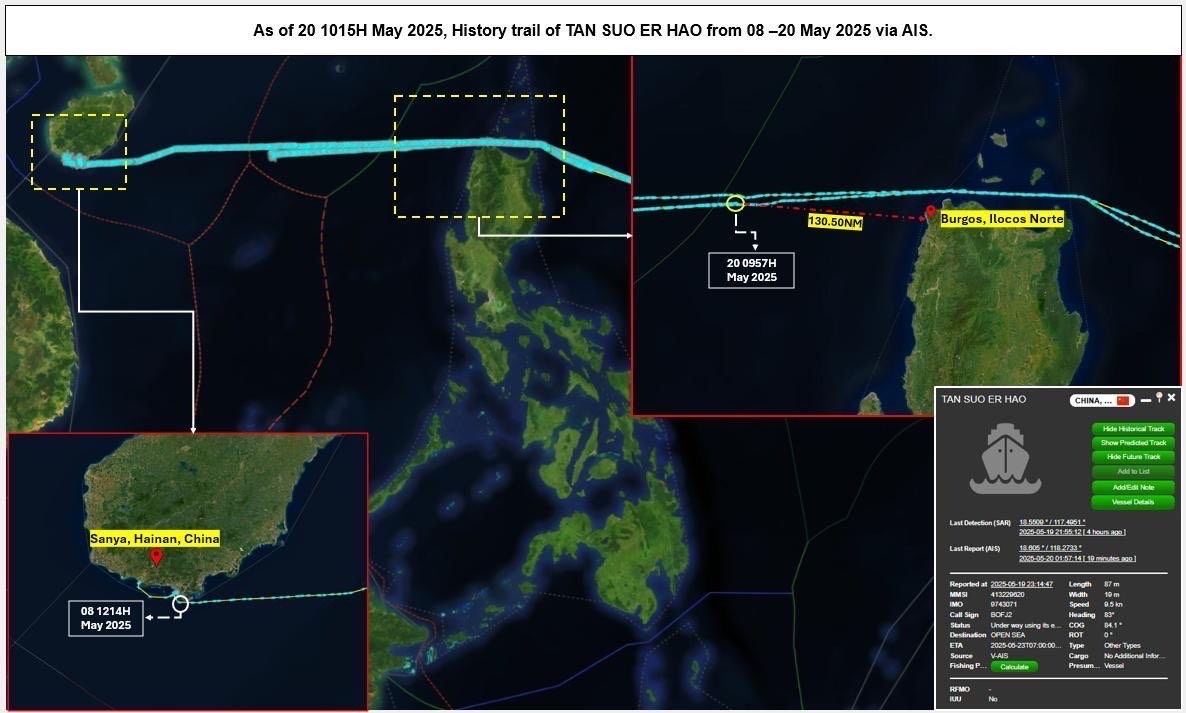Philippine Coast Guard Monitors Chinese Research Vessels in Exclusive Economic Zone

On Tuesday, the Philippine Coast Guard (PCG) announced that it has been actively monitoring the presence of two Chinese research vessels operating within the country’s exclusive economic zone (EEZ). This development raises concerns regarding maritime sovereignty and ongoing tensions in the South China Sea.
During a press conference, PCG spokesperson Commodore Jay Tarriela provided details on the identified vessels, named Xiang Yang Hong 302 and Tan Suo Er Hao. The Xiang Yang Hong 302, which is operated by China's State Oceanic Administration, was reported to have departed from Hainan, China, on May 1. At 8 a.m. on Tuesday, it was located approximately 180 nautical miles off the coast of Rizal, Palawan.
Commodore Tarriela elaborated on the capabilities of the Xiang Yang Hong 302, stating, "This research vessel is intended for use by the People's Liberation Army Navy of China for oceanographic studies. With an impressive overall length of 100 meters and weighing 4,500 tons, it is equipped for deep-sea surveying and comes with remotely operated vehicles and underwater drones." These advanced capabilities highlight China's expanding maritime research and surveillance activities in the region.
Regarding the second vessel, the Tan Suo Er Hao, Commodore Tarriela noted that it had left Hainan on May 8 and was found approximately 130.5 nautical miles from Burgos, Ilocos Norte. This vessel is managed by the China Ocean Mineral Resources Research and Development Association (COMRA) and operates under the guidance of the Institute of Deep-sea Science and Engineering. Similar to the Xiang Yang Hong 302, it is also equipped for deep-sea research.
To ensure maritime security and monitor these vessels, PCG chief Admiral Ronnie Gil Gavan has deployed an aircraft specifically for conducting maritime domain awareness flights, particularly focusing on the Tan Suo Er Hao. This proactive measure aims to maintain vigilance over foreign activities within the Philippines' EEZ.
In addition to the two Chinese vessels, the PCG reported the presence of another research ship named Zhong Shan Da Xue. This vessel had been monitored within the Philippines’ EEZ but had returned to Guangdong by 9:56 a.m. on Tuesday. Tarriela explained that the Zhong Shan Da Xue had departed from Guangdong province on March 31 and had conducted extensive marine scientific research in the northern regions of the EEZ, even crossing into the Taiwan Strait at times. It returned to Guangdong province on May 20.
Tarriela stressed that the navigation patterns of these vessels suggest that the Chinese government cannot deny its involvement in marine scientific research in the area. The Zhong Shan Da Xue is owned and operated by Sun Yat-sen University, which raises further questions regarding the dual-use nature of such research operations.
While the Chinese government may argue that these activities are purely for scientific and civilian purposes, Tarriela indicated that there are concerns that the scientific findings could be shared with the People’s Liberation Army Navy (PLAN) for military applications. This potential military connection adds to the complexity of the situation.
The backdrop to these developments is the ongoing territorial disputes in the South China Sea, a crucial maritime area through which over $3 trillion of trade passes annually. China claims nearly the entirety of the South China Sea, a claim that overlaps with territorial assertions made by the Philippines, Vietnam, Indonesia, Malaysia, and Brunei. In an effort to reinforce its claims, the Philippine government has rebranded parts of this maritime region as the West Philippine Sea.
The West Philippine Sea encompasses maritime areas to the west of the Philippine archipelago, including key regions such as the Luzon Sea and the waters surrounding the Kalayaan Island Group and Bajo de Masinloc.
In a landmark ruling in 2016, the Permanent Court of Arbitration in The Hague favored the Philippines in its disputes with China, stating that China’s claims had “no legal basis.” Despite this ruling, China has steadfastly refused to recognize the court's decision, continuing to assert its claims in the contested waters.



























